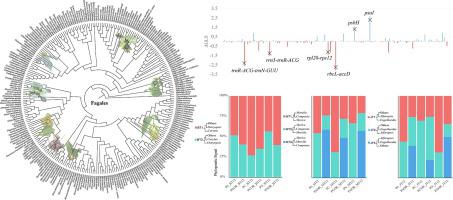Molecular Phylogenetics and Evolution ( IF 4.1 ) Pub Date : 2021-06-13 , DOI: 10.1016/j.ympev.2021.107232 Ying-Ying Yang 1 , Xiao-Jian Qu 2 , Rong Zhang 3 , Gregory W Stull 3 , Ting-Shuang Yi 1

|
Plastid phylogenomic analyses have shed light on many recalcitrant relationships across the angiosperm Tree of Life and continue to play an important role in plant phylogenetics alongside nuclear data sets given the utility of plastomes for revealing ancient and recent introgression. Here we conduct a plastid phylogenomic study of Fagales, aimed at exploring contentious relationships (e.g., the placement of Myricaceae and some intergeneric relationships in Betulaceae, Juglandaceae, and Fagaceae) and dissecting conflicting phylogenetic signals across the plastome. Combining 102 newly sequenced samples with publically available plastomes, we analyzed a dataset including 256 species and 32 of the 34 total genera of Fagales, representing the largest plastome-based study of the order to date. We find strong support for a sister relationship between Myricaceae and Juglandaceae, as well as strongly supported conflicting signal for alternative generic relationships in Betulaceae and Juglandaceae. These conflicts highlight the sensitivity of plastid phylogenomic analyses to genic composition, perhaps due to the prevalence of uninformative loci and heterogeneity in signal across different regions of the plastome. Phylogenetic relationships were geographically structured in subfamily Quercoideae, with Quercus being non-monophyletic and its sections forming clades with co-distributed Old World or New World genera of Quercoideae. Compared against studies based on nuclear genes, these results suggest extensive introgression and chloroplast capture in the early diversification of Quercus and Quercoideae. This study provides a critical plastome perspective on Fagales phylogeny, setting the stage for future studies employing more extensive data from the nuclear genome.
中文翻译:

Fagales 的质体系统发育分析揭示了冲突和古代叶绿体捕获的特征
质体系统基因组学分析揭示了被子植物生命之树中的许多顽固关系,并且考虑到质体在揭示古代和最近基因渗入方面的效用,除了核数据集之外,质体系统发育学继续在植物系统发育学中发挥重要作用。在这里,我们对 Fagales 进行了质体系统发育研究,旨在探索有争议的关系(例如,杨梅科的位置和桦木科、胡桃科和壳斗科中的一些属间关系)并剖析整个质体中相互矛盾的系统发育信号。将 102 个新测序的样本与公开可用的塑性体相结合,我们分析了一个数据集,其中包括 256 个物种和 34 个 Fagales 总属中的 32 个,这是迄今为止最大的基于塑性体的研究。我们发现对杨梅科和胡桃科之间的姐妹关系的强烈支持,以及强烈支持桦木科和胡桃科中替代类属关系的冲突信号。这些冲突突出了质体系统基因组学分析对基因组成的敏感性,这可能是由于非信息位点的普遍存在和质体不同区域的信号异质性。Quercoideae 亚科中的系统发育关系在地理上是结构化的,可能是由于无信息位点的普遍存在和跨质体不同区域的信号异质性。Quercoideae 亚科中的系统发育关系在地理上是结构化的,可能是由于无信息位点的普遍存在和跨质体不同区域的信号异质性。Quercoideae 亚科中的系统发育关系在地理上是结构化的,Quercus是非单系的,它的部分与共同分布的旧世界或新世界 Quercoideae 属形成进化枝。与基于核基因的研究相比,这些结果表明在栎属和栎属的早期多样化中存在广泛的基因渗入和叶绿体捕获。这项研究提供了关于 Fagales 系统发育的关键塑性组观点,为未来使用来自核基因组的更广泛数据的研究奠定了基础。

































 京公网安备 11010802027423号
京公网安备 11010802027423号